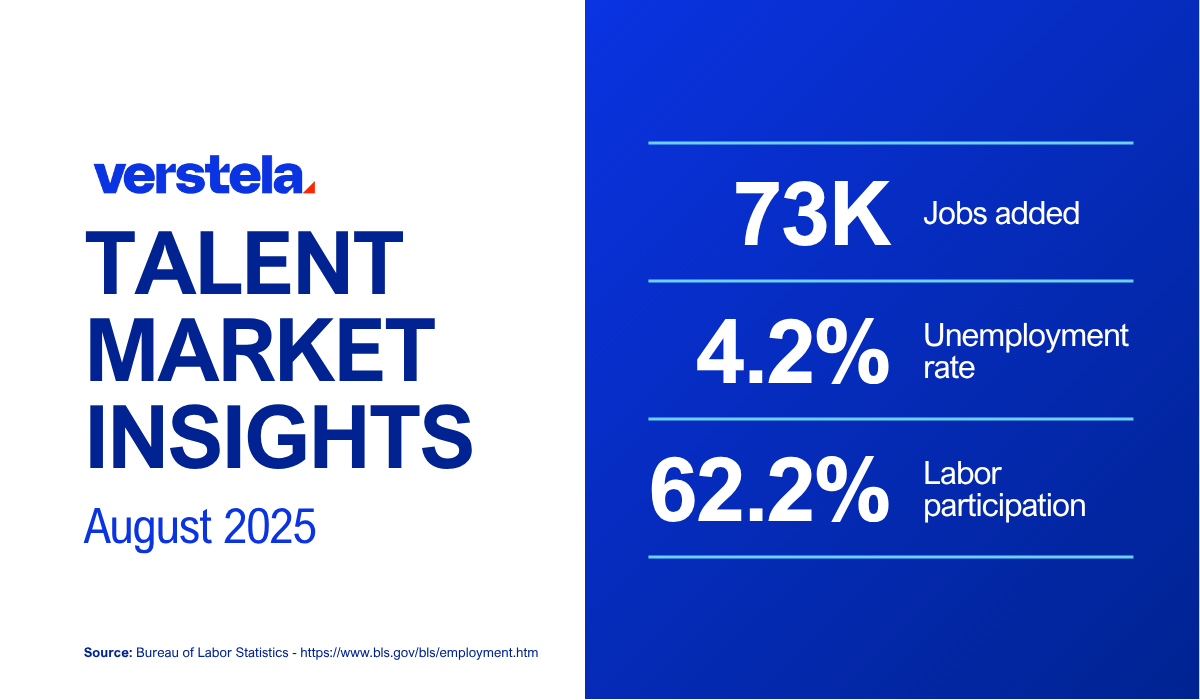
The latest BLS report shows slowing job growth and new signs of softening. While unemployment remains steady, hiring has flattened across most sectors, and major downward revisions to prior months reveal job gains were weaker than initially reported.
For employers, this points to a labor market that’s still functioning but losing momentum.
Key takeaways from the July report:
- 73,000 jobs were added in July
- Unemployment rate ticked up to 4.2%
- Labor force participation dipped to 62.2%
- Wage growth rose 0.3% month-over-month
- May and June’s job gains revised down by a combined 258,000
Below, we break down the data and what it means for workforce planning and hiring in the months ahead.
Number of jobs available
Total job gains slowed in July, with only 73,000 jobs added. Health care posted the largest gain with 55,000 (well above its 12-month average of 42,000), and social assistance also trended upward with 18,000.
Federal government jobs decreased by 12,000, continuing a downward trend that’s seen 84,000 jobs lost since January.
Other major industries, including manufacturing, construction, retail, and professional services, saw little or no change.
Unemployment and labor participation
Unemployment changed little at 4.2%, remaining in the narrow range of 4% to 4.2% it’s maintained since May 2024. But below the surface, several signs point to strain:
- Long-term unemployment rose by 179,000 to 1.8 million. This number amounts to nearly a quarter of all unemployed people.
- New entrants to the labor force increased by 275,000, suggesting more people are looking for work but not securing roles as quickly.
- Labor force participation dipped to 62.2%, down 0.5 percentage points year-over-year.
Wage growth
Wages grew by 0.3% in July, bringing the 12-month average to 3.9%.
This moderate pace suggests less pressure from competition for talent. Combined with a longer average job search and declining participation, this trend points to a slowly loosening labor market.
Economic variables to keep an eye on
While July’s data shows some job growth, new signals highlight emerging risks:
- Revisions showed a weaker labor market: May and June payroll figures were revised down by a combined 258,000 jobs—the largest such downward revision since March-April 2020—underscoring that earlier reports likely overstated labor momentum.
- Growth remains sector-specific: Nearly all new jobs came from healthcare and social assistance. Most other sectors are flat or declining.
- Talent availability may tighten unevenly: Participation is falling, long-term unemployment is rising, and new jobseekers are not securing roles as quickly.
- Wage growth is stable, but expectations may shift: With less hiring pressure, employers may find more room to revisit compensation strategies and pay structures.
These developments suggest a labor market that is still functioning but softening under the surface.
Winning moves for employers
Despite the slowdown, there’s still room to hire and plan with intention. Consider these strategies:
- Prioritize essential roles. Hiring hasn’t stopped. Focus on high-impact positions and streamline your process to stay competitive.
- Support a wider talent pool. As jobseekers re-enter the market or search longer, consider candidates with transferable skills or growth potential.
- Use staffing to stay flexible. Temporary or project-based talent can help you stay productive without long-term commitments.
Stay Prepared
This isn’t a downturn, but it is a shift. These early signs are worth paying attention to.
At Verstela, we help employers make sense of the signals—and act on them. Whether you need help filling roles, planning ahead, or building flexibility into your workforce, we’ll help you stay ready.
Looking for more insights? Visit our Employer Resource Center for practical tools, hiring tips, and market updates.



